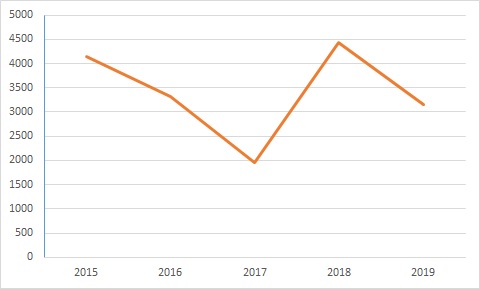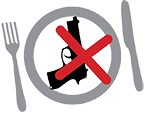As part of its small arms policy, the state of Israel refrains from collecting and revealing data on small arms proliferation, gun crime and gun caused deaths, injuries and damages. The statistics that are, nevertheless, published are selective and often unclear. In some cases, different authorities publish conflicting data.
Comprehensive, detailed data, that is collected methodically and published consistently, is vital to the transparent, democratic formulation and management of small arms policies. In the absence of a state managed data base, Gun Free Kitchen Tables takes steps to construct a (partial) civic data base, subject to our limited resources as a small civil society initiative. We follow reports on gun violence in the media and the network of GFKT activists regularly provides us with new items and information. Among other measures, we also submit repeated requests for data under the Freedom of Information Act. When these are ignored or rejected, we follow up with Administrative Petitions, which have so far achieved partial results (some of which were nonetheless significant).

Gun violence victims
Women Victims
32% of the women murdered in Israel in 2018 were shot to death with firearms.
(Atty. Miriam Zalkind, Director of Policy Promotion and Legislation, Israel Women’s Network)
Almost 38% (44 out of a total of 117) of the women from Israel who were murdered by intimates or family members between October 2000 and September 2005, were shot and killed with firearms. (Sachs, D., Sa’ar, A., Aharoni, S., p. 603)
Firearm victims in Palestinian Society in Israel
From the start of 2000 through October 2019, almost 1,400 Palestinian citizens of Israel were murdered, more than 90 of these, in the course of 2019. The police and the Ministry of Public Security do not provide systematic data on the topic. However, the majority of these victims were apparently killed with unlicensed firearms
(Haaretz; MK Ahmad Tibi, based on Aman Center)
Out of 68 murder victims in Palestinian society in Israel in 2012, 43 were murdered with firearms (63%).
Out of 56 murder victims in Palestinian society in Israel in 2013, 42 were murdered with firearms (75%).
(Nohad Ali, Violence and Crime in Arab Society in Israel, p. 80)
According to police data, the percentage of persons in Israel’s Arab society who are involved in physical violence is twice the percentage of Arabs in the general population. The discrepancy is even higher for murder investigations, with a percentage that is 2.5 times higher than the percentage of Arabs in the general population (Israel Police, Israel Comptroller’s Report).
- In the years 2014 to 2016, the percentage of criminal shootings among the Palestinian Arab population in Israel was 17.5 times higher than the percentage of such incidents among the Jewish population. The percentage of persons injured or killed in armed violence in the Palestinian population was 2.5 to 12 times higher than the percentage of those injured or killed in similar incidents in other sections of Israel’s society (ibid).
In 2014-2016 the suspects of 95% of the criminal shootings in residential areas in Israel were from Israel’s Palestinian citizenry (ibid).
From the start of 2014 till the end of October 2016, thirty Arab women were murdered in Israel, representing 42% of all the women murdered during this period in Israel (amounting to twice their percentage of the population) (Israel Police, Report by Knesset Research and Information Center).
Victims killed with security firms’ off-duty firearms
From 2002 through 2013, at least 18 women and 18 men were shot and killed in the home and family sphere with the firearms of private security firms. Enforcement of the law banning guards from bearing company arms after duty, which was partly achieved due to GFKT advocacy, completely stopped such killings from 2014 to 2016, for the first time in eleven years. Following an amendment to the law in 2016 allowing companies to send guards home with guns, the killings resumed and as of March 2020 three women and one man have been shot and killed with such off-duty guns.
Source: Gun Free Kitchen Tables. The Victims (detailed list).
Firearm Injuries
In the first four months of 2019, 32 gunshot wounded reached the emergency ward of Rambam Hospital in Haifa, as opposed to 14 during the first four months of the previous year, representing a rise of 130%. 29 of the 32 persons sustaining gunshot wounds were Palestinian citizens of Israel, 18 of them from the Galilee community of Tamra.) Ynet)
Out of 223,140 people hospitalized with trauma injuries between 2010 and 2015 (The National Center for Trauma and Emergency Medicine Research):
- About 4.6% (10,315) sustained injuries due to violence (not including combat or terrorist attacks)
- About 13% of trauma injuries due to violence were caused by firearms – from 220 to 242 a year.
Types of violence 2010-2015
(Number of trauma victims from violence: 10,315)
- The number of injured hospitalized due to all forms of violence dropped over the reported period, with the sole exception of firearm injured.
Severity of injuries
Number of trauma victims in critical and serious condition according to types of violence:
- Firearm injuries are the most serious in terms of critical and seriously injured victims (23%), with a sharp increase in the year 2015.
- There has been a rise in the number of violence victims critically injured with firearms.
Demographic data
- Almost all the trauma victims injured by violence are male (89%).
- Over 60% of victims hospitalized due to violence are young men aged 15-35.
- Percentage of immigrants from former USSR, from Ethiopia, of refugees and migrant workers aged 15-35 is significantly higher among victims of violence than their percentage among other victims of other types of injuries.
- Immigrants from Ethiopia are hospitalized due to violence 2.7 times their percentage of the general population and immigrants from the former USSR are hospitalized 1.8 times their percentage of the general population.
- 44% of the victims of violence aged 15-35 are Arabs – an overrepresentation relative to their percentage of victims of injuries in other circumstances (34%) and 1.8 times their percentage of Israel’s general population.
- Among Arabs injured by violence, a relatively high percentage are injured by firearms (24% vs. 2%-9% in other groups).
- In the northern part of the country, a higher percentage of victims of violence are injured with firearms (16% vs. 11%-12% in other parts of the country).
How many guns altogether in the civil sphere - 2014?
At the close of 2014, there were an estimated 320,000 licensed small arms (civilian, police and military) circulating through the civil sphere in Israel and the West Bank (besides and not including military and police stockpiles). In addition, estimates placed the number of unlicensed firearms at hundreds of thousands (in 2013, the police estimated the number at 400,000).
(GFKT, Loose Guns, p. 13; Crime in Arab Society: Faults in Police Treatment, p. 32)

May 2019
Privately owned firearms: 147,814
(Office of the State Attorney, Ministry of Justice, Respondents statement, Petition to the High Court of Justice 8451.18, May 19, 2019, Item no. 43.)
August 2016
Privately owned firearms: 142,919, including 21,905 newly licensed firearms in the six-month period from October 2015 to May 2016.
Organizational firearms: 123,489, including 28,403 firearms newly licensed to security guards and 83,800 newly licensed organizational firearms in the six-month period from October 2015 to May 2016.
Licensed civilian firearms in total: 266,408, of which almost 40% – 105,705 – were newly licensed in the six-month period from October 2015 to May 2016. This is the period before the appointment of Gilad Erdan as Minister of Public Security and his introduction of increasingly looser gun licensing policies.
(The Ministry of Public Security, August 15 2016, Letter in response to a GFKT request for information.)
License holders and licensed firearms
Private civilian firearms and licenses
Private civilian firearms and licenses – 2014-1992

(“Loose Guns“, pg.)

- Out of all applications for private civilian gun licenses submitted in 2019, 4% were for women and 96% were for men. Most of the persons licensed to bear arms are aged 21 to 45.
- More than half of applications for private civilian licenses in 2019 were submitted under the new criterion (instated in August 2018) of military rifleman training level 07 or more.
- The period of 2015 to 2017 saw a drop in applications for private civilian gun licenses and a corresponding drop in the number of licenses approved. Following the introduction of expanded criteria for private civilian licenses, a sharp rise occurred during 2018 in the number of applications submitted and approved under the new, extended criterion (of rifleman 07 or more):
The number of applications for private civilian gun licenses opened and approved under the criterion of service in the security forces

(Ministry of Public Security, December 23 2019 and February 6 2020, in response to a GFKT request for information)
The effects of expanded licensing criteria – August 2018

*As of August 20, 2018, new licensing criteria expanded eligibility for private civilian firearms licenses to include persons who completed “service in the security forces” and underwent standard infantry training (known as “rifleman 07”).
(Office of the State Attorney, Ministry of Justice, Respondents statement, Petition to the High Court of Justice 8451.18, May 19, 2019, Item no. 45.)
By the end of April 2019, reviews were completed for 4,926 applications for firearm licenses submitted subject to the criterion of “service in the security forces.”
Of these:
- 3,817 new licenses were approved – 77% of the applications reviewed
- 1,109 applications were denied – 23% of the applications reviewed
The remaining applications were still under review.
(Office of the State Attorney, Ministry of Justice, Respondents statement, Petition to the High Court of Justice 8451.18, May 19, 2019, Item no. 45.)
In previous years an average of half (about 50%) of applications for firearms licenses were rejected.
(The Ministry of Public Security, August 15 2016, Letter in response to a GFKT request for information)
Note: The above statistics do not reflect the total number of new applications submitted since the new licensing policy was announced. In addition, they do not reflect the total number of new civilian licenses approved. They account only for the private civilian licenses approved under the criterion of “service in the security forces.” According to the state, these only constitute about 12% of the total of private civilian license holders. Also missing from this data are the number of civilian organizational firearms to which the new licensing policy applies as well and whose guns represented almost half of all civilian firearms in 2016.
Organizational civilian firearms and licenses

(Ministry of Public Security, in response to a GFKT request for information on organizational firearms licenses, February 3 2020)
How much (civilian) gun control – 2014
In 2014, six officials at the Ministry of Public Security were responsible for oversight of a total of 274,000 civilian arms and arms bearers, approximating one official overseeing about 48,000 guns and license bearers. As of January 2019, no positions were added to these six. Both before and up to 2019, a single ministry official exercised general national oversight.
(Gun Free Kitchen Tables, Loose Guns, English Summary, p. 15; The committee appointed to examine the implementation of licensing procedures in Israel and headed by former Chief of Police, Dan Ronen, at a meeting with Atty. Meisa Irshaid and Rela Mazali of GFKT, Jan. 14 2019.)
How many guns in private security firms
2018 – 130,000 firearms held by private security
Source [in Hebrew]: Former Police Chief David Tzur, in an interview with Galit Lubetzky, Educational TV, “Osim Seder,” July 15 2018.
2016 – 28,403 of these firearms were licensed to private security guards
(The Ministry of Public Security, August 15 2016, Letter in response to a GFKT request for information.)
2016 – Approximately 70,000
(Amitay Levy, Chief of Security Services, Israel Police, testifying before the Knesset Committee of Interior Affairs on March 9 2016)

(“Loose Guns“, pg.)
Issues and Facts

Would you like to get our updates?
Subscribe to our mailing list


